- The Pangolin Consortium, a partnership between six U.S. zoos and Pangolin Conservation, an NGO, launched a project in 2014 which today houses fifty White-bellied tree pangolins (Phataginus tricuspis).
- Common knowledge says that pangolins are almost impossible to keep alive in captivity, but the consortium has done basic research to boost survival rates, traveling to Africa and working with a company, EnviroFlight, to develop a natural nutritious insect-derived diet for pangolins in captivity.
- While some conservationists are critical of the project, actions by the Pangolin Consortium have resulted in high captive survival rates, and even in the successful breeding of pangolins in captivity.
- The Pangolin Consortium is able to conduct basic research under controlled conditions at zoos on pangolin behavior and health – research that can’t be done in the wild. Zoos can also present pangolins to the public, educating about their endangered status, improving conservation funding.

“When we first started talking about pangolins, people thought we were saying ‘penguin,'” says Amy Roberts, Curator of Mammals at Chicago’s Brookfield Zoo. That remains a problem, even today, with the majority of Americans still not knowing what pangolins look like, much less how much deep trouble they’re in.
This is just one issue addressed by the Pangolin Consortium – a partnership of six U.S. zoos, along with the Florida-based NGO, Pangolin Conservation. This alliance, begun in 2014, now holds around fifty African White-bellied tree pangolins (Phataginus tricuspis) including a few born in captivity.
Which is remarkable, considering that the common wisdom is that captive pangolins almost always quickly waste away and die.
There are eight species of wild Asian and African pangolins in the world today, all under extreme pressure from illegal trafficking – especially due to hunting for bushmeat and use of their scales in traditional medicine.
Often called the world’s most trafficked mammal, all eight species are considered by the IUCN to be threatened with extinction. Numbers of the Chinese pangolin (Manis pentadactyla) have declined by 90 percent, and recent research showed that 2.71 million pangolins of the African species are killed every year in Central Africa, an increase of 145 percent since 2000.
Some conservationists argue that pangolins – with such rapidly plummeting wild populations, and perceived high rates of mortality in zoos – should not be held at all in captivity. But the Pangolin Consortium argues just the opposite: to conserve remaining wild populations, scientists need to know far more about these unusual animals, data that can only be gleaned under controlled conditions like those seen in zoos.
The Pangolin Consortium is working diligently to gain that knowledge, and has already made significant breakthroughs. And the more they learn about captive pangolins, say these experts, the more hope there may be for wild ones.


The captive pangolin diet
Diet was widely supposed to be the biggest problem with keeping pangolins healthy and alive in captivity, so that was the first problem that Justin Miller, founder of Pangolin Conservation, set out to solve.
In the wild pangolins eat insects, using a long, sticky tongue similar to that of an anteater. This diet can be challenging to replicate for a number of reasons. “For a long time, zoos fed them everything from mince meat to dog food, milk, eggs – nothing insect-based –just readily available food that the pangolin would accept,” Miller says.
He had become familiar with research done in Taipei, Taiwan where zoos achieved success at keeping and breeding the local pangolin species, data that clarified some key dietary factors. However, just adopting the Taipei diet wasn’t an option, as it included ingredients not readily available in the United States, such as bee larvae and silkworm pupae.
So Miller initiated his own research in 2013. First he needed to figure out exactly what wild White-bellied tree pangolins eat. He went to Africa to observe pangolin eating habits and to collect insects, sending them back to the U.S. for nutritional analysis. Miller recalls that he needed a lot of bugs, so he hired locals to gather them, despite the fact that this wasn’t the most appealing business opportunity.

“It was hard to convince people to catch ants,” he says. “When I tried to show them how, it was just entertainment to watch me be bitten en masse during a few failures. I had to start an impressive system of supply and demand with ant prices changing daily, and even hourly, to get the amounts needed.”
Next Miller had to convert that nutritional analysis into a food product using ingredients readily available in the United States. Sourcing those ingredients involved networking and creativity. One important consultant was John Gramieri, the Austin, Texas Zoo’s general curator, and former director of the Association of Zoos and Aquariums (AZA) Taxon Advisory Group in charge of xeanrthrans (anteaters, armadillos and sloths), aardvarks and pangolins.
Gramieri had helped develop a similar insect-derived diet for captive armadillos, shifting the animals away from the meat diet generally served them in zoos. “I bemoaned the fact that there was very little opportunity in this country to buy insect matter in a manner that was cost effective,” Gramieri says. “If you wanted to feed an armadillo nothing but mealworms, that was incredibly expensive.”

Then, one day, someone showed him a United Nations report on insects for human consumption, and it mentioned a company called EnviroFlight. The firm was raising black soldier flies and producing rose fertilizer from their castings and fish food from their larvae. He sent EnviroFlight an email, wondering if there was some chance he could get the raw insects minus the processing.
“They called me and said, ‘We’ve got two tons of this stuff in the freezer, what do you want to do with it?’” he says.
This led to a couple years research developing an ideal insect-based armadillo diet, which put Gramieri in the perfect position to advise Miller and connect the pangolin researcher with suppliers. Again, Enviroflight turned out to be an excellent collaborator and supplier, but then the delivered insect larvae caused practical problems.
“First we got [the larvae] in whole, and they broke a bunch of machines because they gummed them up,” says Jennifer Watts, director of nutrition at the Brookfield Zoo.

“The only way we could effectively grind them up, because of the [high] fat content, was to put dry ice with them, freeze them, then grind them,” Miller relates. “But then EnviroFlight said, ‘we can use a cold press, and we can press out the fat and give you what’s left over.'” The company was also able to modify the amount of protein and nutrients in the larvae based on what they were fed.
Once Miller designed a nutritionally complete pangolin diet, he acclimated the animals to it while they were still in Africa. “I started them off on their wild diet of ants and termites, and then slowly switched them over to the prepared diet,” he says. This way, when the animals arrived in the U.S., they didn’t need to be persuaded to eat strange food while also acclimating to new surroundings. Lessening stress, the researchers were learning, meant happier, healthier pangolins.
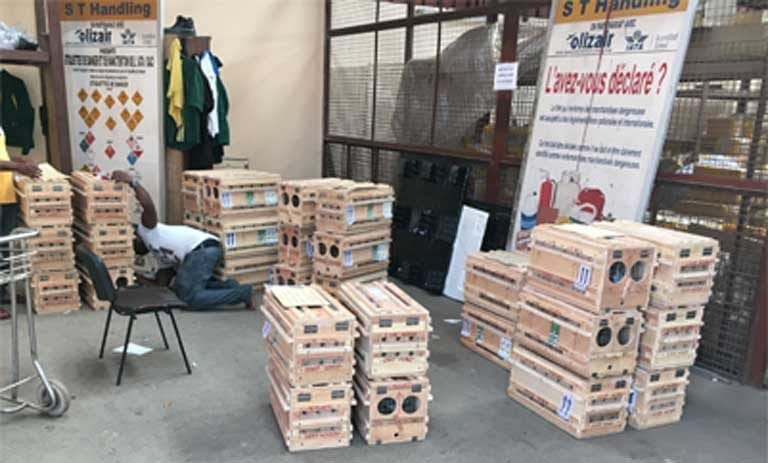
Preparing for the big move
Another reason pangolins have done poorly in captivity historically is that often captive animals in the past were rescues from trafficking confiscations, so they started out in poor health, which only got worse.
Confiscated pangolins “have been in stressful conditions, either obtained from bushmeat markets or hunters,” explains Miller. “They can go through capture myopathy – a buildup of stress that ends up damaging their heart muscles.” When that happens, animals may appear to be doing well, but there is [cardiac] damage, “and then any sort of stressful event can lead to heart failure.”
This and other health deficits due to illegal wildlife trafficking puts the animals at a high risk of dying in transit, or shortly thereafter.
In contrast, the Pangolin Consortium did everything possible to assure that the animals brought to the U.S. beginning in 2015 started out in good health. While still in their native countries, the pangolins were treated for parasites and infections, with Miller assessing each individual. “Any specimens that showed signs of stress, or any other factors that made them poor candidates, were released into safe areas near their original collection sites [in the wild].” That turned out to be about thirty percent. The remaining captive pangolins were adapted slowly to the presence of people and unusual noises, “primarily consisting of NPR [National Public Radio] and [electric] fans,” Miller says.
Miller also minimized the stress and risk of travel, replacing the shocks on transport vehicles to give a smoother ride. “All vans had air conditioning, and I had a spare van follow us in case of vehicle problems. We only traveled during the night so the otherwise busy roads would be clear and allow for shorter transit time and cooler weather in case of air conditioner problems,” he relates. “I never let any specimens out of my sight until they were loaded onto the plane. Even then, I stayed at the cargo warehouse until the plane was in the sky.”

Settling in
Once in the United States, the first priority was to ensure the wellbeing of the pangolins. Only one was put on public exhibit, at Brookfield, while the rest remained in seclusion.
“What everyone has committed to is making sure these animals are well established behind the scenes,” says Gramieri. “We want to do a full and detailed analysis of their behavior, their hormone values, their food consumption. We want to be able to assess that in a private, non-trafficked space, so if we do put them on display, we’ll be able to see if their behavior changes at all.”
At Brookfield, the researchers will be analyzing stress hormones, determining the estrous cycle, and monitoring pregnancies – natural processes never scientifically observed in this, or pretty much in any African pangolin species.
“We are collecting fecals on everyone, every day, for the first year,” Roberts says. The animals are kept in slightly different environments, to see if minor variations affect their behaviors and health. For example, two settings utilize true reverse lighting to simulate nocturnal conditions, while another allows some daylight in. “There are differences in keeper activity, humidity, noise. We’re tracking [all of that] so we can correlate down the road with the fecal hormone results.”
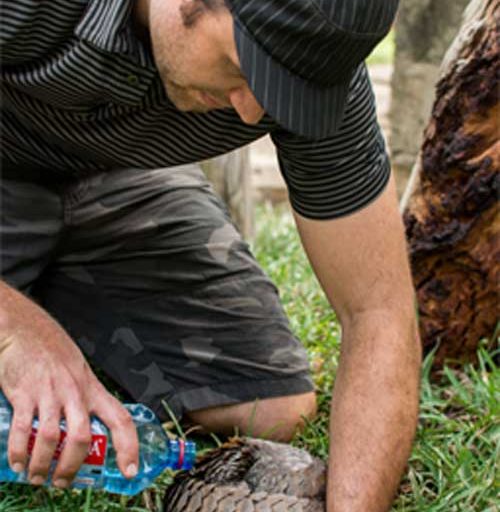
Meanwhile, Miller’s facility is starting a study, analyzing stress hormones in any pangolins utilized in public outreach presentations to make sure those individuals are not being negatively impacted.
It’s hoped that all of this advance planning, attention to detail and careful research is likely to increase the chance of success with Phataginus tricuspis, as is the coordination and communication within the consortium.
“We’ve never been in a better position within the zoological community to quickly exchange information between facilities and rapidly analyze data like nutritional requirements,” Miller reports. “For example, say our animals have their blood analyzed and it shows a nutritional deficiency. We can then rapidly alter the diet, send it off for analysis, and follow up with new blood work weeks later.”
In addition, Grameiri’s research has now led him to question the conventional wisdom that pangolins do poorly in captivity. In fact, he says, their lifespans at zoos were improving even before the Pangolin Consortium project began. He has analyzed longevity records and found survival trend statistics that are much better than the figures often cited, which he says incorrectly interpreted data from currently living animals. By analyzing records of 296 pangolins held in zoos since the animals first appear in records in 1954, he found that the captive lifespan has steadily increased. The 45 animals in zoos at the time of his analysis had been in human care for an average 7 years 8 months, which included many that had been in captivity more than ten years so far.
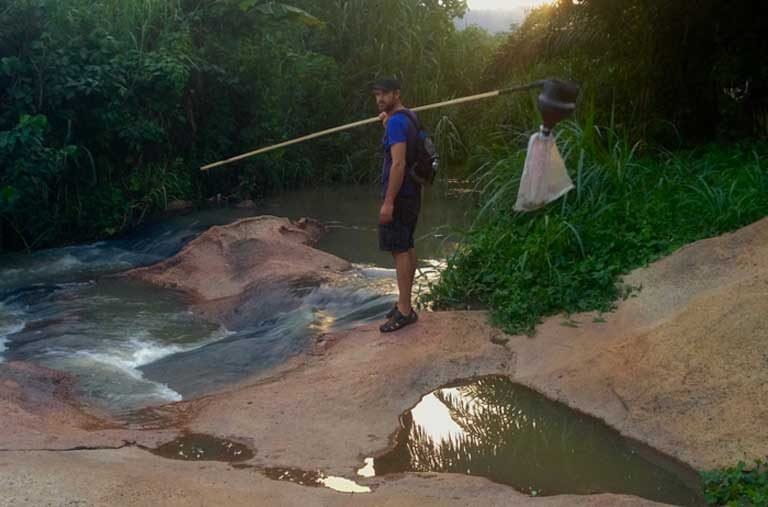
Breeding pangolins
Helping pangolins survive better in captivity is one thing, breeding pangolins in captivity is quite another matter. Miller says that captive breeding was never a realistic possibility before in Western zoos, because most facilities had so few animals to work with, and because many had been confiscation rescues in poor health.
But there was evidence it could be possible – the Taipei Zoo bred Formosan pangolins to the third generation. And indeed, the Pangolin Consortium project has already seen successful zoo births. Most offspring, like two recently weaned at Brookfield, had mothers already pregnant when they arrived at the zoo. However, in November, Miller’s facility saw a successful birth from an animal bred since arriving.
Maintaining genetic diversity is important for captive populations, and advance planning is underway to assure it. “We’re doing genetic work on each and every individual of all the founder animals to figure out which to breed together for the maximum amount of diversity,” says Miller. “For a lot of species we don’t have that [baseline data] for the founder stock.”
While there are no current plans to release captive animals to the wild – where the situation for pangolins is still dire – this attention to genetic health of a captive population will be important for any future reintroductions.
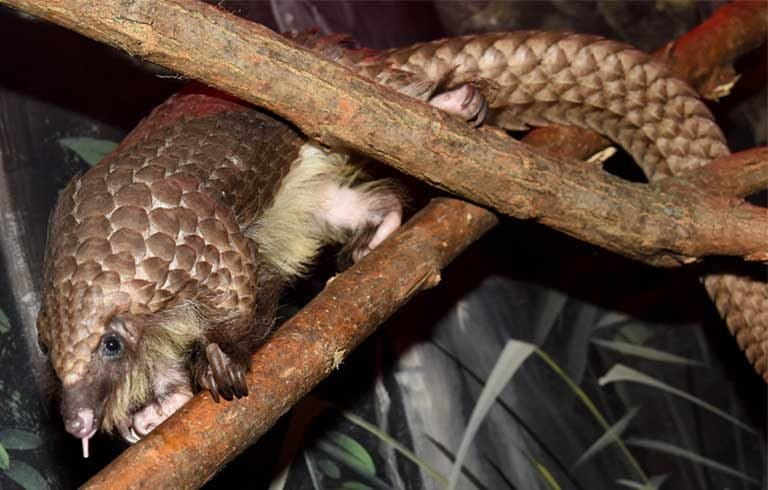
Ambassadors and more
Some conservationists have objected to the strategy of bringing pangolins into captivity.
Along with the concerns about maintaining them in good health in captivity – an issue that the Pangolin Constortium’s work seems to be addressing successfully – another concern that has been expressed is that the collecting of pangolins for zoos places additional pressure on wild populations. Gramieri thinks it’s worth looking at the statistics: according to conservative estimates “there’s more than a pangolin an hour being poached.” Compared to poaching figures in the millions, the number of animals that have been taken into zoos is miniscule.
Pangolin Consortium participants argue that the contribution their efforts make to preserving pangolins in the wild far outweigh the capture of small numbers of individuals, and they have taken significant steps toward that goal. For example, every U.S. zoo that received pangolins was required to pledge its support to in situ conservation. “All the facilities signed off on a strict set of agreements to ensure that this collaborative consortium facilitated research and conservation goals,” says Miller. This includes a mandatory yearly donation that will be pooled and distributed to selected grant applicants who are conducting in situ and ex situ conservation projects.
The consortium is also assisting conservation in the wild in other ways. Knowledge gained about the behaviors and breeding of captive pangolins will almost certainly provide useful information that will help their wild relatives.
“We’re doing research that would be very difficult in the wild,” says Miller. For example, existing pangolin “reproduction data was grossly inaccurate – such as gestation and age of maturity, basic modeling of the population and what is sustainable – none of this is [currently] known, and all can be based off data [gathered] from our captive population.”
The careful veterinary attention given to captive pangolins, and veterinary knowledge gained, also has the potential to aid wild populations, especially animals seized from traffickers and in need of immediate medical care and rehabilitation in preparation for return to the wild.
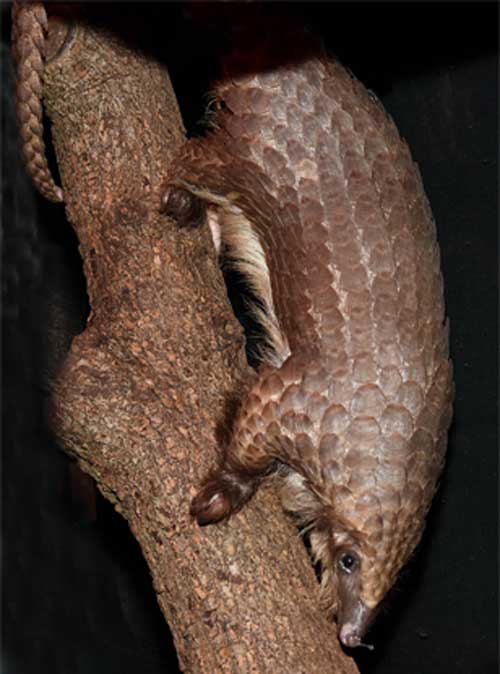
Miller says it’s unclear how effective current rehabilitation practices are, but notes that the baseline health data gathered at the zoos could be critical to contributing to the health of confiscated and wild populations. He points out that this is information that cannot be easily gathered or analyzed in rehab facilities.
Rehab centers “may never have seen a healthy pangolin heart,” he says. “They could be releasing specimens that won’t fare well because they have damaged hearts.” Data from a healthy captive population will make it possible to more accurately assess the health of rehabbed animals before release, upping their chances for survival back in the wild.
There is one last argument in support of the Pangolin Consortium’s captive pangolin program, which brings us back to where this story began: nobody is likely to care about conserving pangolins if they’ve never heard of them, and can’t even keep pangolins straight from penguins.
When it comes to conservation, public education, recognition and awareness matters. That’s clearly why the Eastern mountain gorilla is receiving significant amounts of conservation funding today, while the Bornean white-bearded gibbon is not.
Gramieri points out that while only one pangolin is on exhibit right now, when it becomes possible to display more, the combined consortium zoos could potentially expose more than seven million visitors per year to this amazing keritan-armored animal.
“We think this is a very important way of getting the American people involved in the plight of the pangolin,” Gramieri says.
Put that potential for education together with the financial and research support for in situ conservation, and the Pangolin Consortium can be seen as a bold innovator: offering a proactive conservation model by which zoos support in situ species survival. Says Gramieri, “This is exactly what zoos are supposed to do.”
FEEDBACK: Use this form to send a message to the author of this post. If you want to post a public comment, you can do that at the bottom of the page.
Note: A number of Mongabay readers have asked for a complete list of the Pangolin Consortium partners. They are the Brookfield Zoo, Gladys Porter Zoo, Columbus Zoo, Pittsburgh Zoo, Turtle Back Zoo, Memphis Zoo, and Pangolin Conservation.
Response to Mongabay Pangolin Article (Posted Feb 9, 2018)
By Lisa Hywood, CEO & Founder of Tikki Hywood Foundation, Zimbabwe and Thai Van Nguyen, Executive Director, Save Vietnam’s Wildlife, Vietnam
We are writing in response to the Jan. 5 article in Mongabay entitled “U.S. Zoos Learn How to Keep Captive Pangolins Alive, Helping Wild Ones.”
The article, which excluded insights from any pangolin conservation groups, asserts that the “Pangolin Consortium” – a partnership between six U.S. zoos and a non-profit organization – is saving pangolins by taking them from the wild in Togo and keeping them in U.S. zoos.
One of the main problems with this rationale – that we can save pangolins by transitioning them to captive environments – is that pangolins have a very high mortality rate during capture and in captivity. As such, displaying them in zoos might require a constant flow of wild pangolins into captivity. This is something we can’t risk given pangolins are threatened with extinction and are the most trafficked mammal on earth, with over one million poached for their scales (used in traditional Asian medicine) and meat over the past decade. Indeed, pangolins are in such grave danger that the International Union for the Conservation of Nature (IUCN) Pangolin Specialist Group – the world’s foremost experts on pangolins – expressed serious concern with the Consortium’s actions in a recent letter to the Association of Zoos and Aquariums (AZA).
Fortunately, at a recent meeting between organizations working on pangolin conservation and the Consortium, the zoos committed to stop importing pangolins from the wild. In other words, even if those they have die; they will not be replaced with wild-caught pangolins. While we remain concerned about the way in which the Consortium acquired its original 45 pangolins, this is an extremely positive step.
We are hopeful that the Consortium will now adhere to global conservation action plans developed for pangolins by the IUCN Pangolin Specialist Group, which outline the top priorities for saving such species, such as reducing consumer demand and stopping illegal trafficking. Indeed, zoos can and should be involved in saving these species – as they have other threatened animals – through actions like supporting rescue, rehabilitation and release facilities in countries that make up the pangolins’ habitat like Zimbabwe’s Tikki Hywood Foundation and Save Vietnam’s Wildlife; launching initiatives in consumer nations to help reduce the demand for pangolins; and developing digital media and awareness raising campaigns to raise the profile of pangolins globally.
Pangolin populations have undergone such massive declines that we need all hands on deck to prevent the extinction of these unique animals. This means working together to carry out the conservation plans developed by pangolin experts, which prioritize protecting wild populations and their habitat and cracking down on trade—not removing pangolins from their habitat.

